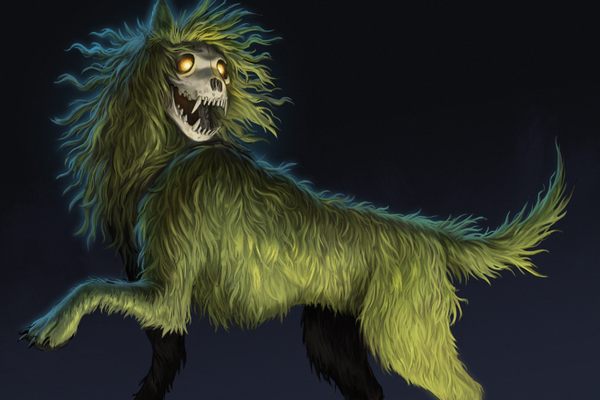On his walk home on the Scottish island of Tiree, a man came across a huge dog, its paw as big as the spread of his palm, near the hill of Kenavara. The black dog was resting on a sandbank near the shore, its thick fur wet with saltwater. The man hesitated, unsettled by the animal’s appearance, and decided to follow another path home. The next day, he retraced his steps, determined to find it. But when he returned to the spot, he saw only the dog’s paw prints.
He followed its trail onto the wind-whipped grassland until the prints disappeared. Although he was disappointed, he was grateful the dog had not spotted him the day before, because he was sure it was something otherworldly.
That terrifying tale, from a compendium of 19th-century Scottish folktales written by John Gregorson Campbell, is but one of many references in the British Isles to death appearing as a dog. Scholars believe dogs appearing as omens of death, and also as minions of the devil, evolved in the islands’ early Christian era. But these tales grew out of much older stories that linked large dogs to fairies and other supernatural beings who appear in ancient, pagan traditions across Europe but particularly in Scotland and Ireland.
In his book, Campbell identifies the dog spotted near Kenavara as Scotland’s feared Cù Sìth, one regional variation of the ominous black dog. The animal shows up in Ireland as the Cù Sidhe, while the Cwn Annwn roam Wales and the Gabriel Ratchets, sometimes called Gabble Ratchets, can be found in Northern England (ratchets were a type of hound). The dog’s Gaelic names specifically tie it to fairies, or fae. “Cù” means hound and “Síth” or “Sidhe” is the word for both fae and the mounds where they lived.

While they were often black, Cù Sìth sometimes appeared to be green, a color “generally connected with bad fortune and also the color most commonly associated with the fae, magic, and the supernatural,” says Mark Norman, author of Black Dog Folklore. The dogs were sometimes described as being owned or employed by the fairies, and used to kidnap humans to serve the fae, Norman adds. In some folktales, the Cù Sìth spent much of their time around the ring forts, sometimes called fairy forts, found throughout Scotland and Ireland, as well as hills and mountains. For instance, there are numerous accounts of ghostly black dogs wandering the slopes of the Scottish mountain Schiehallion, also known as Sìdh Chailleann, the Fairy Hill.
As Christianity spread across the British Isles beginning in the sixth century, the fae and their hounds did not fit into its rigid framework of good and evil. Under the influence of the Church, the Cù Sìth became one of many animals said to be either a minion of the devil or Satan himself in disguise.
Likewise, the mounds and ring forts where it was commonly seen became associated with gateways to the subterranean Christian hell, says Jenny Butler, a lecturer on folk religious traditions at the University College Cork.
As the Christian belief system mingled with older traditions across the British Isles, several of the regional black dog traditions, including Cù Sith, became associated specifically with the Wild Hunt, a deeply ancient myth. Variations are found across Central and Northern Europe, but the tradition describes otherworldly hunters racing across a stormy sky, often in pursuit of human souls. The Cù Sith and other black dogs accompanied the hunters in some tellings of the tale. Over time, says Norman, the dogs were seen as a guide “conveying souls of the departed to the afterlife.” Soon there were sightings around graveyards as well as fairy circles.
“There are stories of the black dog emerging out of the grave, or jumping up off of the coffin, or following people from the graveyard,” says Butler. The black dog was eventually seen as death itself, or at least a terrible omen of it.
Perhaps not surprisingly, folktales warn that when a person outside hears the first howl of the Cù Sìth, they should run indoors. Hearing three howls or barks could cause the listener to die from fright.
So tonight, especially if the storm clouds roll in, listen for the howl of a dog carried on the chill night air. Whether you believe it is death itself, an ancient evil, or just an animal announcing itself to the world, know that you are hearing the same sound that struck fear into your ancestors. And, well, best stay indoors till morning.

